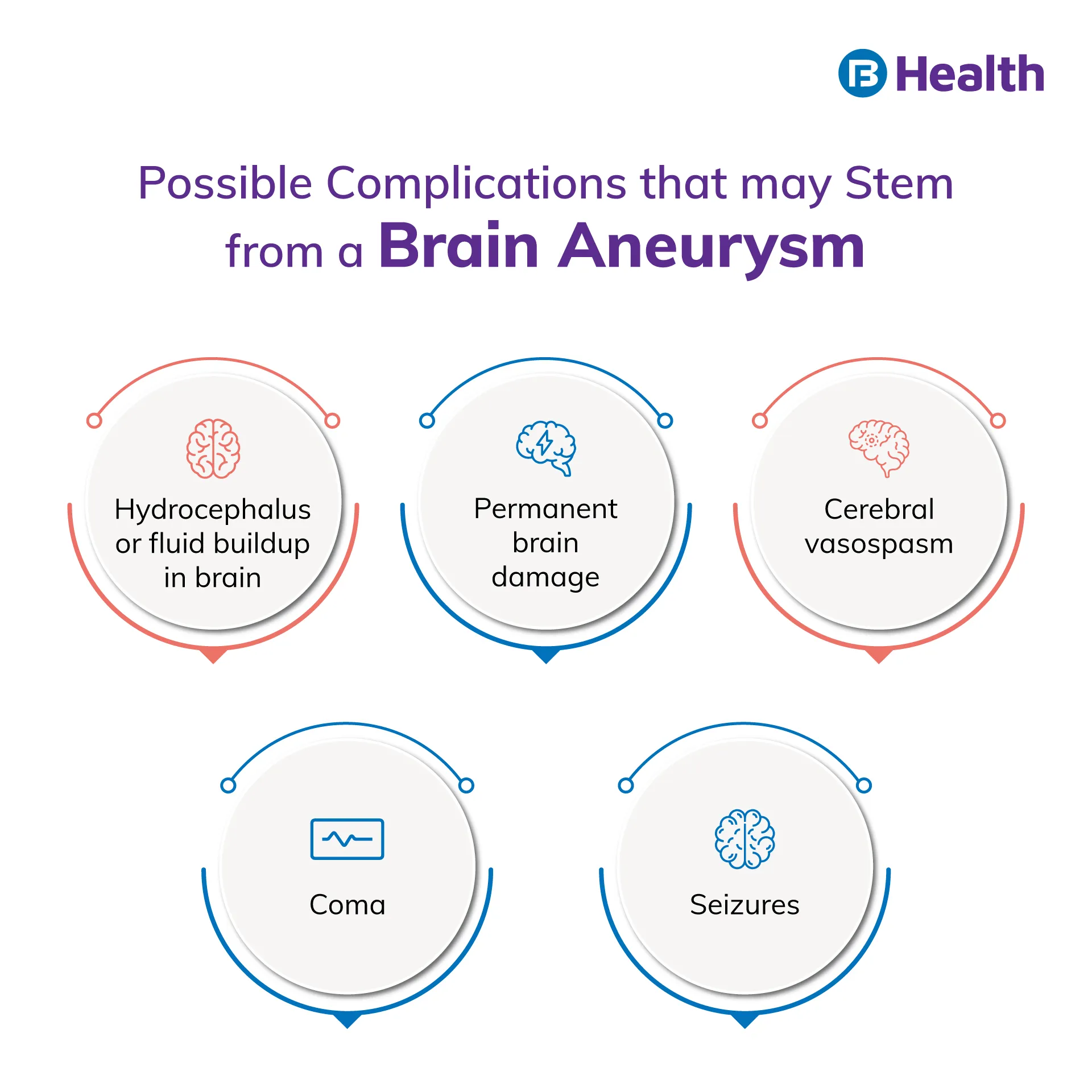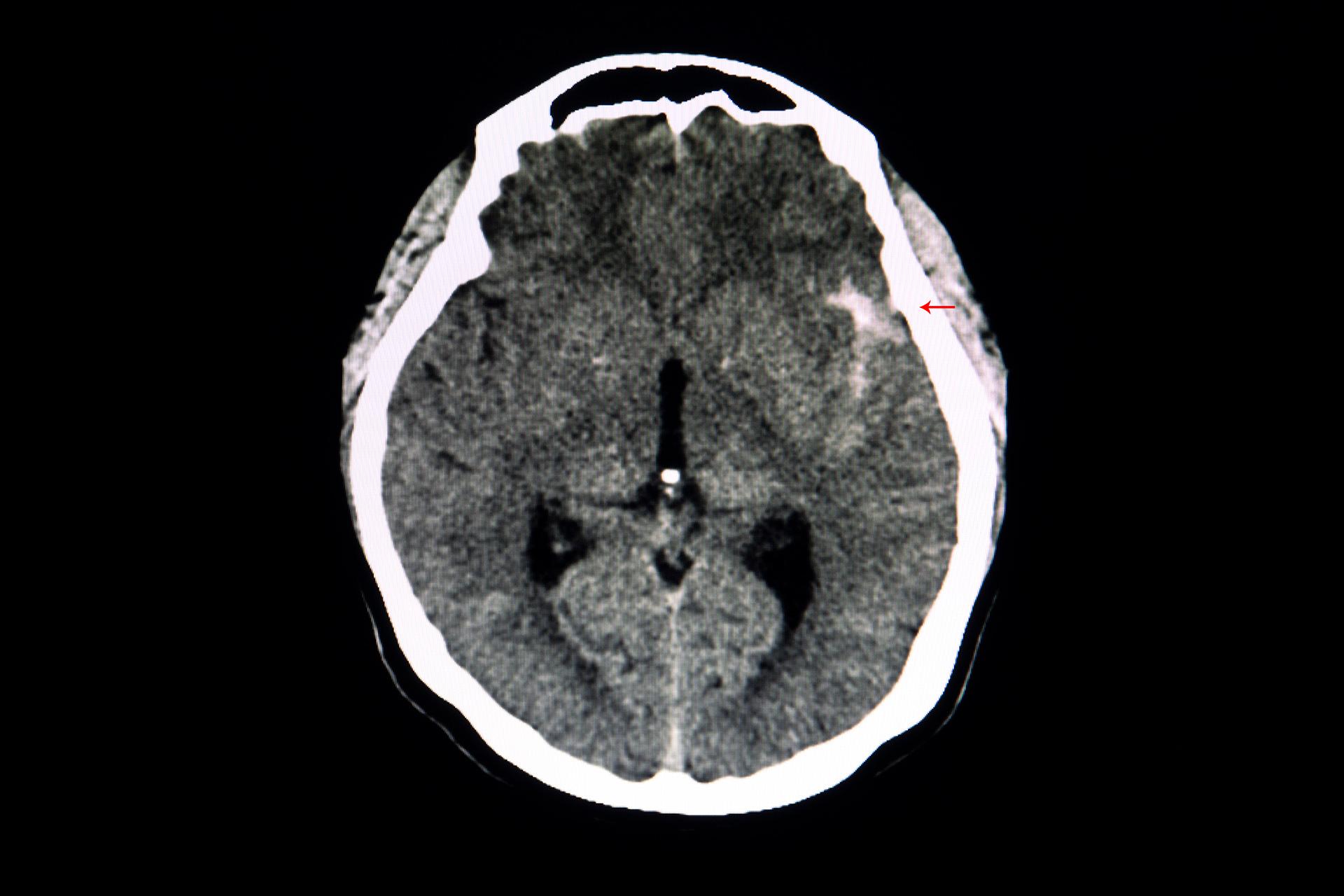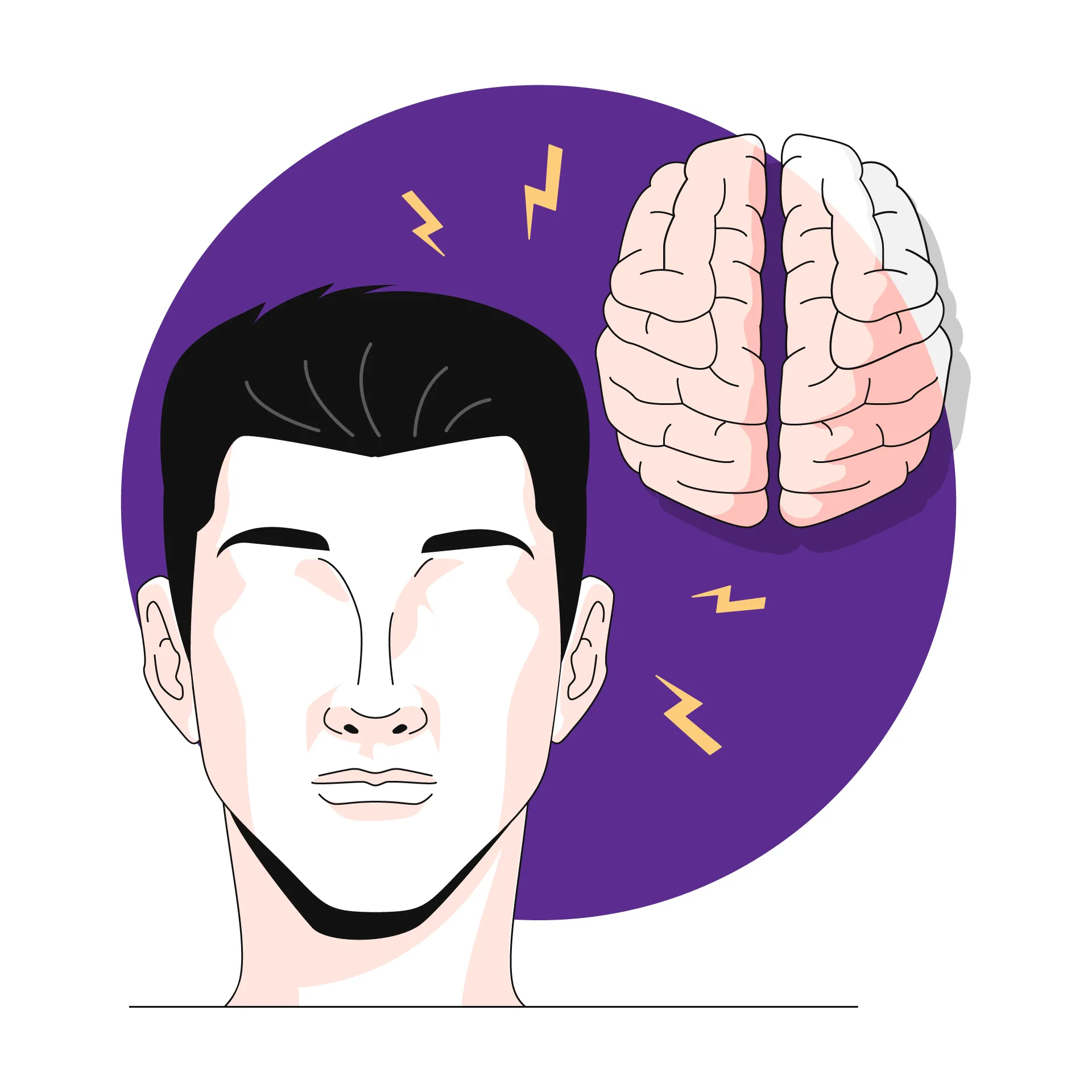Brain Aneurysm: Causes, Complications, Diagnosis, Risk Factor
- Brain Aneurysm Symptoms
- Brain Aneurysm Type Symptoms
- Brain Aneurysm Causes
- Who Gets Brain Aneurysms?
- Brain Aneurysm Treatment
- Risk Factors For A Brain Aneurysm
- How Is A Brain Aneurysm Diagnosed?
- Complications Of Brain Aneurysms
- Brain Aneurysms in Children
- Brain Aneurysm Prevention
- How To Take Care Of Mental Health?
Key Takeaways
- Headache, nausea, and vomiting are some brain aneurysm symptoms
- A ruptured brain aneurysm is a life-threatening medical emergency
- The brain aneurysm treatment includes surgery and lifestyle changes
A brain aneurysm or cerebral aneurysm is a blister-like bulge or ballooning in the blood vessel of the brain. In severe cases, it can cause a rupture or leak, which may lead to a hemorrhagic stroke or bleeding in the brain. A brain aneurysm is a weak spot in the walls of a blood vessel in the brain. When the weak area gets worn out due to blood flow, it bulges out. There are different types of brain aneurysms such as saccular and fusiform aneurysms.
In India, up to 2 lakh+ cases of brain aneurysm are reported every year [1]. While an unruptured aneurysm may not cause any problems, a ruptured brain aneurysm can be life-threatening and requires immediate medical support. Read on to learn about its symptoms, causes, and treatments.
Brain Aneurysm Symptoms
A person with a ruptured brain aneurysm may have the following symptoms:
- Severe headache
- Nausea
- Vomiting
- Drowsiness
- Seizure
- Dizziness
- Blurred or double vision
- Drooping eyelids
- Dilated pupils
- Loss of balance
- Loss of consciousness
- Confusion
- Mental weakness
- Stiffness in neck
- Light sensitivity
- Speaking difficulties
- Heart attack
- Weakness or numbness in arms or legs

A person with an intact or unruptured brain aneurysm shows the following symptoms:
- Headache
- Drooping eyelid
- Difficulty speaking
- Seizures
- Pain in neck
- Nausea and vomiting
- Dilated or enlarged pupils
- Blurred or double vision
- Change in vision
- Pain near the eyes
- Pain above and behind the eye
- Numbness or weakness in one side of the face
Brain Aneurysm Type Symptoms
Aneurysms in the brain are unpredictable and may not exhibit symptoms until they get large or rupture. Large or ruptured aneurysms often produce distinct symptoms and necessitate immediate medical attention.
As a result of either rupture or no rupture, the symptoms and warning signals of a ruptured brain aneurysm differ.
Unruptured aneurysms
Small aneurysms usually do not show any symptoms. On the other hand, an expanding aneurysm may strain adjacent nerves and tissues, generating symptoms.
Only 10 to 15% of aneurysms that have not ruptured cause symptoms. A brain aneurysm that has not ruptured can cause the following symptoms:
• Eye discomfort or headache
• Weakness on one side of your face
• Blurred or double vision
• A dilated pupil
Leaking aneurysms
An aneurysm can rupture and spill a small amount of blood into the brain. When you have a leaking brain aneurysm, you may feel a severe headache. It is known as a sentinel headache.
Sentinel headaches can appear days or weeks before a brain aneurysm ruptures fully. Get urgent medical attention if you have a sudden, severe headache, especially if it gets accompanied by other aneurysm symptoms.
Ruptured aneurysms
• a sudden, severe headache
• a drooping eyelid
• neck stiffness
• a change in mental state or mental state or trouble speaking
• trouble walking or dizziness
• sensitivity to light
• nausea or vomiting
• seizures
• blurry or double vision
• loss of consciousness
A ruptured aneurysm can be fatal. If you have more than one of these symptoms, get emergency medical assistance immediately.
Brain Aneurysm Causes
Common causes of brain aneurysms, including risk factors
- Old age
- Infection
- Plaque buildup in arteries
- Tobacco smoking
- Birth abnormalities
- Head injury or trauma
- Excessive consumption of alcohol
- Head and neck cancers or tumors
- Family history or genetic disorders
- Hypertension or high blood pressure
- Drug abuse – cocaine or amphetamines
- Connective tissue disorders and polycystic kidney disease [2, 3]
Who Gets Brain Aneurysms?
You are more prone to develop a brain aneurysm if you:
- Are female
- Age from 40 to 60
- Have a family history of aneurysms
- Suffer from a rare blood vessel condition, i.e., cerebral arteritis, fibromuscular dysplasia, or arterial dissection
- Possess a hereditary connective tissue disorder such as Ehlers-Danlos syndrome, Marfan syndrome, neurofibromatosis type 1, or Loeys-Dietz syndrome
- Have kidney-polycystic disease
- Have a congenital abnormality known as a brain aneurysm
Brain Aneurysm Treatment
Treatment options available for brain aneurysms:
Surgical clipping
In surgical clipping, a surgeon cuts or removes a small part of your skull to access or locate the aneurysm. Then, a small metal chip is attached to the base to pinch off the aneurysm or stop the blood flow. Later, the skull is sealed. This surgery is done in cases of both ruptured and unruptured brain aneurysm.
Endovascular coiling
For this procedure, surgery is not required to open the skull. The surgeon places a catheter into your wrist or groin to the affected blood vessel that has the aneurysm. Small platinum coils are then placed in the aneurysm. This treatment is considered safer than surgical clipping.
Flow diverter surgery
Doctors choose this treatment is chosen when neither surgical clipping nor endovascular coiling are possible. This surgery is done to treat larger brain aneurysms. For this procedure, a metal-made stent is inserted inside the affected artery of your brain. This is done to divert the blood flow from the aneurysm.
Apart from these surgical treatments, you can control or reduce the risk of popping brain aneurysms that are small or unruptured through lifestyle changes. Such brain aneurysms may not need treatment at all. Consult with your doctor to know which modifications you need to do. Here are some changes your doctor may advise:
- Quit smoking
- Stay away from drugs
- Exercise and control your diet
- Take steps to reduce high blood pressure such as limiting caffeine or avoiding lifting heavy materials
Risk Factors For A Brain Aneurysm
Several risk factors can increase your chances of developing a brain aneurysm. Here are a few examples:
- Age: Most aneurysms occur in people over 40
- Sex: Women are more likely than men to have aneurysms
- A family tree: You are more likely to get aneurysms if you have a family history
- Hypertension: Untreated high blood pressure, often known as hypertension, can strain the walls of your arteries
- Smoking: Smoking can damage the walls of your blood vessels and raise your blood pressure
- Abuse of alcohol and drugs: Alcohol and drug abuse, especially cocaine and amphetamines, can elevate blood pressure and promote arterial inflammation
- Brain damage: In rare cases, a severe head injury might damage the blood arteries in your brain. It results in the formation of an aneurysm
- Genetic disorders. An aneurysm is more likely to occur due to structural or functional alterations brought on by specific genetic disorders. Here are a few examples:
- ADPKD (autosomal dominant polycystic kidney disease)
- Ehlers-Danlos syndrome
- Marfan syndrome
- Congenital issues: Blood vessel weaknesses likely exist from birth. Disorders such as arteriovenous malformations or aortic coarctation, which narrows the aorta, can further increase the risk of aneurysms
- Infections: Some infections can damage the artery wall and increase the risk of aneurysms. These are known as mycotic aneurysms
How Is A Brain Aneurysm Diagnosed?
An aneurysm may be difficult to diagnose unless it ruptures. However, some tests can detect brain aneurysms in patients with a family history of the condition, risk factors, or inherited aneurysm-related health problems. An aneurysm might also get identified during examinations for other health concerns such as headaches or seizures. Imaging can detect brain aneurysms by seeing brain structures and arteries and detecting the existence of an aneurysm. Any one of the following imaging tests may get performed:
Magnetic resonance imaging (MRI)
An MRI scan creates images of your brain by using radio waves and magnetic fields. It's very beneficial for detecting and analysing aneurysms that haven't ruptured. Magnetic resonance angiography, a form of MRI, can produce comprehensive images of brain arteries that can aid in determining the location, size, and shape of an aneurysm.
Computed tomography (CT)
A CT scan uses several X-rays to create horizontal pictures of the brain. CT scan images detect brain bleeding caused by a leaky or ruptured aneurysm. CT angiography is a sort of CT scan that employs a specific dye to assist your doctor see how blood flows in your brain's arteries more clearly.
Digital subtraction angiography (DSA)
DSA involves inserting a tiny, flexible tube called a catheter into a groyne artery. After that, the catheter gets inserted up to the brain. Through the catheter, a particular dye gets released into the brain. A computer then generates images from X-ray images taken before and after the dye was applied. These images solely show blood arteries and no other surrounding structures like bone.
Cerebrospinal fluid (CSF) tests
Because of an aneurysm, imaging may not always clearly detect bleeding. In this case, your doctor may request a CSF test, which you can obtain through a lumbar puncture. The existence of blood in a CSF sample can indicate brain hemorrhage.
A lumbar puncture can be dangerous for some people because changes in spinal fluid pressure can cause brain herniation. Therefore, this test should get performed with caution during an evaluation for a brain aneurysm, but it is not always an indicator.
Complications Of Brain Aneurysms
A ruptured aneurysm in the brain might result in a haemorrhagie stroke. It occurs when blood leaks into the brain or the space between the skull and the brain.
Bleeding caused by a ruptured aneurysm can result in several potentially fatal consequences. A ruptured brain aneurysm can lead to the following complications:
Seizures:
Seizures are one of the probable effects of a burst brain aneurysm. They can occur during or immediately after the rupture of an aneurysm.
Vasospasm:
This happens when the blood capillaries in your brain suddenly narrow, shutting off blood supply to some part of the brain.
Hydrocephalus:
This condition occurs when CSF circulation gets impeded, and CSF collects in the brain, causing swelling. Hydrocephalus can develop within days of a ruptured brain aneurysm and can be a long-term problem, necessitating the insertion of a shunt.
Furthermore, even after therapy, a brain aneurysm might rupture again.
Brain Aneurysms in Children
A brain aneurysm can occur in children under the age of 18. Boys are eight times more likely than girls to get them. Around 20% of the few instances in youngsters have "giant" aneurysms (larger than 2.5 centimetres).
Aneurysms in children can occur for no apparent reason. However, they get linked to the following:
- Head trauma
- Connective tissue problems
- Infection
- Genetic abnormalities
- Family history
Brain Aneurysm Prevention
Tips and strategies for preventing brain aneurysms
There is a slim chance that aneurysms will disappear on their own. The good part is that you can prevent them from developing or leaking. You can also reduce the risk of new aneurysms by:
- Quitting smoking
- Consuming a well-balanced diet
- Exercising regularly and avoiding heavy lifting (stick to moderate exercise)
- Avoiding the use of cocaine or other stimulants
- Seeking treatment for any alcohol or drug abuse issues
- Managing your high blood pressure with medication and lifestyle modifications.
How To Take Care Of Mental Health?
Studies show that those with a brain aneurysm suffer from depression, poor mental health, and anxiety [5]. Such a diagnosis can also be stressful and disheartening. To ensure your mental well-being, you can follow these tips.
Exercise and stay active
Exercises such as swimming, cycling, walking, and gardening reduce anxiety, negative mood, and depression [4].
Eat a balanced diet
Food also plays a big role in maintaining your mental health. An ideal diet includes fruits, vegetables, cereals, nuts, seeds, oily fish, dairy products, and lots of water.
Seek help
Taking care of your health should be your priority. Talking about or sharing your problems with your loved ones can help. You can also learn how to take care of mental health from therapists or psychologists. These mental health experts can teach you mindfulness techniques to manage anxiety and depression.
Additional Read: Types of Mental IllnessesTo address any symptoms of brain aneurysm or to take care of your mental wellness, book an online doctor consultation on Bajaj Finserv Health. Booking doctor appointments is easy with a range of experts online! This way, you can lead a healthy and active life.
Please note that this article is solely meant for informational purposes and Bajaj Finserv Health Limited (“BFHL”) does not shoulder any responsibility of the views/advice/information expressed/given by the writer/reviewer/originator. This article should not be considered as a substitute for any medical advice, diagnosis or treatment. Always consult with your trusted physician/qualified healthcare professional to evaluate your medical condition. The above article has been reviewed by a qualified doctor and BFHL is not responsible for any damages for any information or services provided by any third party.




